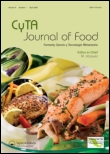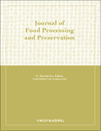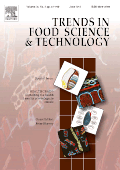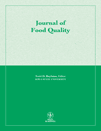
CyTA-Journal of Food
Scope & Guideline
Advancing food science for a sustainable future.
Introduction
Aims and Scopes
- Food Quality and Safety Management:
Research related to the assessment and enhancement of food quality and safety, including microbiological safety, shelf-life extension, and quality control measures. - Nutritional Science and Functional Foods:
Studies that explore the nutritional properties of food products, functional food development, and the health benefits associated with dietary components. - Innovative Food Processing Techniques:
Research focused on new technologies and methods in food processing, including preservation techniques, extraction methods, and the use of novel ingredients. - Biotechnology in Food Production:
Investigations into the application of biotechnology in food production, including fermentation processes, probiotic development, and enzyme technology. - Sustainable Food Practices:
Research that promotes sustainability in food systems, including the utilization of by-products, eco-friendly packaging, and reducing food waste. - Food Chemistry and Bioactive Compounds:
Studies that analyze the chemical composition of food, focusing on bioactive compounds, their interactions, and effects on health.
Trending and Emerging
- Plant-Based and Alternative Proteins:
Increasing research on plant-based foods and alternative protein sources reflects growing consumer interest in sustainable diets and health-conscious eating. - Food Biotechnology and Probiotics:
A trend towards exploring the role of probiotics and bioactive compounds in food for health benefits, showcasing the relevance of biotechnology in modern food production. - Smart Food Packaging Solutions:
Research focused on innovative packaging technologies that enhance food preservation and safety, aligning with sustainability goals and consumer demand. - Food Waste Reduction Strategies:
An emerging focus on methods to minimize food waste through innovative processing and preservation techniques, reflecting broader environmental concerns. - Nutraceuticals and Functional Ingredients:
Increased emphasis on the health benefits of specific food components, including bioactive compounds and their potential roles in disease prevention and health promotion. - Artificial Intelligence in Food Quality Management:
The integration of AI and machine learning in food quality assessment and supply chain management, indicating a technological shift in food science research.
Declining or Waning
- Traditional Food Preservation Techniques:
There is a noticeable decrease in studies focused on conventional food preservation methods, as newer technologies and approaches gain prominence in the field. - Basic Nutritional Studies without Functional Focus:
Research that simply addresses basic nutritional content without exploring functional benefits or health implications appears to be waning, as there is a growing emphasis on functional foods. - Local or Regional Food Studies:
Investigations that focus solely on local or regional food products without a broader application or relevance to global food systems are becoming less common. - Single Ingredient Studies:
There has been a decline in research that focuses exclusively on the properties of single ingredients without considering their applications or interactions in food systems. - Traditional Culinary Techniques:
Studies centered around traditional cooking methods are less frequently published, as the focus shifts towards innovative and technology-driven culinary approaches.
Similar Journals

JOURNAL OF FOOD PROCESSING AND PRESERVATION
Exploring Cutting-edge Solutions for Global Food SafetyJOURNAL OF FOOD PROCESSING AND PRESERVATION, published by Wiley-Hindawi, stands as a vital resource within the fields of Food Science, Chemical Engineering, and Chemistry. With an ISSN of 0145-8892 and an E-ISSN of 1745-4549, the journal has been a beacon of knowledge since its inception in 1977, continuing to provide valuable insights to the research community until 2024. Recognized for its quality, it holds a noteworthy Q2 ranking in 2023 across multiple categories, including Food Science and Chemical Engineering, indicating its influential contribution to the academic discourse. Although it offers no open access, the journal remains a crucial platform for disseminating groundbreaking research and innovative methodologies in food processing and preservation. Researchers, professionals, and students can significantly benefit from its comprehensive reviews, original research articles, and case studies, aimed at advancing knowledge and practices in food technology. By bridging the gap between theoretical advancements and practical applications, the JOURNAL OF FOOD PROCESSING AND PRESERVATION plays an essential role in addressing global food safety, sustainability, and quality challenges.

Acta Scientiarum Polonorum-Technologia Alimentaria
Pioneering Insights in Food Safety and QualityActa Scientiarum Polonorum-Technologia Alimentaria, published by Poznan University of Life Sciences, is a revered journal in the field of food science, showcasing cutting-edge research and innovations in food technology. Established as a leading platform within its domain, this journal is indexed under Scopus and ranks in the 2023 Q3 quartile for Food Science, demonstrating its commitment to high-quality scholarship. With an ISSN of 1644-0730 and E-ISSN 1898-9594, it serves as a critical resource for researchers, professionals, and students seeking to stay at the forefront of advancements in food safety, quality control, and sustainable practices. The journal has also been recognized for its contributions to the agricultural and biological sciences, positioning itself at rank #205 out of 389 in this competitive field. While currently not offering open access, the journal's valuable insights and findings, especially as it publishes through 2024, play a crucial role in advancing knowledge and fostering collaboration among experts in the food science sector.

ACS Food Science & Technology
Bridging Academia and Industry for Food SolutionsACS Food Science & Technology is a premier peer-reviewed journal published by the American Chemical Society (ACS) that addresses the dynamic intersections of food science, chemistry, and technology. With its E-ISSN: 2692-1944, this journal aims to disseminate innovative research and comprehensive reviews that enhance understanding in fields such as analytical chemistry, organic chemistry, and general food science. Despite the absence of an Open Access model, its position in the Q2 quartile for multiple categories in 2023 underscores its significant impact on the scholarly landscape, ensuring researchers can access high-quality research pertinent to today's food challenges. With an expanding timeline of 2021 to 2024, ACS Food Science & Technology is poised to be an essential resource for advancing the scientific community's knowledge, fostering collaboration, and bridging gaps between academia and industry.

TRENDS IN FOOD SCIENCE & TECHNOLOGY
Pioneering trends that shape the future of food.Trends in Food Science & Technology, published by Elsevier Science London, stands as a premier journal in the fields of food science and biotechnology. With an impressive Q1 ranking in both the food science and biotechnology categories, it is recognized for its rigorous peer-reviewed articles that advance knowledge and innovation in the sector. The journal’s Scopus rankings validate its significance, placing it in the top percentile among its peers, with a remarkable rank of #2 out of 389 in Agricultural and Biological Sciences - Food Science, and #4 out of 311 in Biochemistry, Genetics, and Molecular Biology - Biotechnology. Since its inception in 1990, the journal has become a vital resource for researchers, professionals, and students alike, offering insights into contemporary challenges and trends impacting food technology. Although it operates under a subscription model, the quality of research published within its pages makes it an essential read for anyone involved in advancing the science of food.

Journal of Food Science and Technology-Ukraine
Connecting Global Minds in Food Technology ResearchJournal of Food Science and Technology-Ukraine, published by the Odesa National University of Technology, stands as a pivotal platform dedicated to the dissemination of high-quality research in the field of food science and technology. With its open access policy established in 2014, the journal fosters global knowledge sharing and accessibility, enabling researchers, professionals, and students to access critical findings and advancements in food technology without barriers. The journal's commitment to publishing innovative studies, reviews, and case analyses reinforces its role in addressing contemporary challenges in food safety, preservation, processing, and nutritional quality. With ISSN 2073-8684 and E-ISSN 2409-7004, it serves as a valuable resource for the academic community, supporting the advancement of food science knowledge and its practical applications.

Food Frontiers
Innovating Food Production for Tomorrow's NeedsFood Frontiers, an esteemed publication in the Food Science domain, is proudly published by WILEY. Launched as an Open Access journal in 2020, it aims to facilitate the dissemination of high-quality research that influences contemporary food science and technology. The journal, with an E-ISSN of 2643-8429, has rapidly ascended to a Category Quartile ranking of Q1 in the Food Science category as of 2023, and boasts an impressive Scopus rank of #31 out of 389 in Agricultural and Biological Sciences, placing it in the 92nd percentile. The journal's mission is to explore innovative approaches to food production, safety, and sustainability, making it an essential resource for researchers, industry professionals, and students eager to stay at the forefront of food science advancements. With a commitment to open accessibility, Food Frontiers fosters collaboration and knowledge sharing across the globe, addressing the critical challenges and trends in feeding the world sustainably.

Ukrainian Food Journal
Fostering collaboration in food science and biochemistry.Ukrainian Food Journal is an esteemed open-access journal dedicated to advancing the field of food science and biochemistry. Established in 2012 and published by the National University of Food Technologies in Ukraine, the journal serves as a vital platform for researchers and professionals to disseminate their findings on food technology, safety, and nutritional biochemistry. With an ISSN of 2304-974X and E-ISSN 2313-5891, it offers a wealth of knowledge to its readers, promoting innovation and collaboration within the industry. While currently categorized within the Q4 quartile of biochemistry and the Q3 quartile of food science, the journal is progressively gaining recognition, reflecting a commitment to quality research in a competitive field. The journal is indexed in Scopus, ranking #271 in Food Science and #376 in Biochemistry, underscoring its relevance and contribution to agricultural and biological sciences. The Ukrainian Food Journal not only enriches the academic community with its open-access model but also aims to foster dialogue among researchers, professionals, and students dedicated to improving food systems and nutrition. It operates from its headquarters in Kyiv, offering a hub for creativity and advancement in food-related research.

FOOD TECHNOLOGY AND BIOTECHNOLOGY
Transforming Ideas into Impactful Food InnovationsFOOD TECHNOLOGY AND BIOTECHNOLOGY is a distinguished peer-reviewed journal published by the Faculty of Food Technology and Biotechnology, University of Zagreb, Croatia. Since its inception in 1993, this Open Access journal has become a crucial platform for disseminating innovative research in the fields of food science, biotechnology, and chemical engineering. With a commendable impact factor and consistent Q2 and Q3 rankings across multiple categories—including Biotechnology, Food Science, and Industrial Engineering—this journal not only fosters academic discussions but also addresses real-world challenges in food production, safety, and sustainability. As it converges its thematic scope from 1996 to 2024, FOOD TECHNOLOGY AND BIOTECHNOLOGY remains committed to advancing knowledge through high-quality research and interdisciplinary collaboration, making it an essential resource for researchers, professionals, and students seeking to stay at the forefront of food innovation and biotechnology.

JOURNAL OF FOOD QUALITY
Exploring Excellence in Food Quality and SafetyThe Journal of Food Quality, an esteemed publication under Wiley-Hindawi, stands as a vital resource in the dynamic field of Food Science, established since 1977 and operating under an Open Access model since 2017. With its seat in the United Kingdom, this journal focuses on delivering high-quality research and insights pertaining to food safety, risk management, and quality assurance, reflected in its impressive Q2 ranking in both Food Science and Safety, Risk, Reliability and Quality categories in 2023. Researchers and professionals will find the journal’s contributions indispensable, particularly given its Scopus rankings that place it in the top echelons of its fields, highlighting its impact and relevance. By fostering an environment of knowledge sharing, the Journal of Food Quality not only enhances academic dialogue but also supports innovation and best practices in food research and industry applications.

International Food Research Journal
Pioneering Discoveries in Food Safety and ScienceThe International Food Research Journal, published by UNIV PUTRA MALAYSIA PRESS, serves as a pivotal platform for disseminating innovative research within the field of food science. With an ISSN of 1985-4668 and an E-ISSN of 2231-7546, the journal has successfully established its presence since its inception in 2007, converging its findings through 2024. This esteemed journal holds a Q3 ranking in Food Science, illustrating its valuable contributions to the field as demonstrated by its Scopus rank of 276 out of 389, placing it in the 29th percentile among its peers in Agricultural and Biological Sciences. Although it operates under a traditional publishing model, its academic integrity and focus on high-quality research ensure that it remains a vital resource for researchers, professionals, and students eager to explore advances in food technology, nutrition, and safety. By encouraging interdisciplinary collaboration and critical dialogue, the International Food Research Journal plays an essential role in shaping the future of food science research.